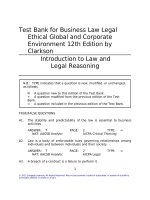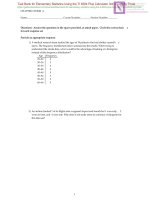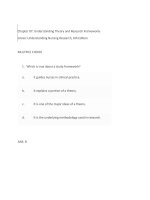Test bank for tietz fundamentals of clinical chemistry and molecular diagnostics 7th edition by burtis
Bạn đang xem bản rút gọn của tài liệu. Xem và tải ngay bản đầy đủ của tài liệu tại đây (32.96 KB, 4 trang )
Test Bank for Tietz Fundamentals of Clinical Chemistry and Molecular Diagnostics 7th Edition by B
Full file Chapter
at />01: Clinical Chemistry, Molecular Diagnostics, and Laboratory Medicine
Test Bank
MULTIPLE CHOICE
1. An individual working in a clinical chemistry laboratory is married to a sales representative
who works for a company that sells chemistry laboratory supplies. When the laboratory
manager requests a list of needed supplies, cost of supplies, and vendors, this individual only
recommends the spouse’s company as the vendor. This is considered to be a(n):
a. accounting issue.
b. possible conflict of interest.
c. maintenance of confidentiality issue.
d. problem with resource allocation.
ANS: B
Concern has been raised over the interrelationships between practitioners in the medical field
and commercial suppliers of drugs, devices, equipment, etc., to the medical profession.
Similarly, relationships have been scrutinized between clinical laboratorians and
manufacturers and providers of diagnostic equipment and supplies. These concerns led the
National Institutes of Health (NIH) in 1995 to require official institutional review of financial
disclosure by researchers and management of situations in which disclosure indicates
potential conflicts of interest.
DIF: 1
REF: Page 4-5
OBJ: 6 | 7
2. A patient visits her physician stating that her prescribed painkiller is not working to reduce
the pain following her recent surgery. A friend of the patient claims that the same painkiller
“worked wonders” to reduce her pain after the same surgery. The physician states that the
difference in the effect of the drug might be caused by ____, which is studied in
pharmacogenetics.
a. epidemiology
b. an inherited disease
c. a conflict of interest
d. a genetic variation in drug-metabolizing enzymes
ANS: D
Pharmacogenetics is the study of the genetic variation of drug metabolism between
individuals.
DIF: 1
REF: Page 3
OBJ: 1
Copyright © 2015, 2008, 2001, 1996, 1987, 1976, 1971 by Saunders, an imprint of Elsevier Inc.
Full file at />
1
Test Bank for Tietz Fundamentals of Clinical Chemistry and Molecular Diagnostics 7th Edition by B
Full file at 3. />John works in a molecular diagnostics laboratory and receives a blood sample that has the
name of a close friend printed on the bar-coded label. The genetic test that is ordered on the
friend’s sample would provide diagnostic information about a disorder that has a poor
prognosis, and the test is usually performed by John. He asks a fellow employee to analyze
the sample for him and not divulge the results. This ethical issue concerns:
a. confidentiality of patient genetic and medical information.
b. a conflict of interest.
c. resource allocation.
d. diagnostic accuracy.
ANS: A
Clinical laboratorians have long been responsible for maintaining the confidentiality of all
laboratory results, a situation made even more critical with the advent of increasingly
powerful genetic testing.
DIF: 1
REF: Page 4
OBJ: 6 | 7
4. Molecular diagnostic testing methods and results can be:
a. qualitative only.
b. quantitative only.
c. either qualitative or quantitative.
ANS: C
Molecular diagnostic methods can be either qualitative or quantitative in nature, depending on
the clinical need.
DIF: 1
REF: Page 3
OBJ: 5
5. Clinical epidemiology, which is the study of the patterns, causes, and effects of health and
disease in certain populations, has provided the clinical laboratory with methods that evaluate
the effects and outcomes of laboratory testing. This allows for a more effective:
a. process of determining the cost of the testing methods.
b. selection and interpretation of laboratory tests.
c. determination of the boundaries between the components of the clinical lab.
d. conduct assessment.
ANS: A
Clinical epidemiologists have introduced methods to evaluate the effects and value of
laboratory testing in healthcare. These developments are expected to play an increasing role in
the selection and interpretation of laboratory tests.
DIF: 1
REF: Page 3
OBJ: 4
Copyright © 2015, 2008, 2001, 1996, 1987, 1976, 1971 by Saunders, an imprint of Elsevier Inc.
Full file at />
2
Test Bank for Tietz Fundamentals of Clinical Chemistry and Molecular Diagnostics 7th Edition by B
Full file at 6. />Analysis of which one of the following by molecular diagnostic methods provides a measure
of processes that are ongoing at the time of blood sampling?
a. Genetic variation in an individual’s response to a drug
b. Circulating plasma nucleic acids
c. Malignant lymphomas
d. Histocompatibility
ANS: B
Molecular diagnostics, given its very high sensitivity, has been applied to the study of plasma
nucleic acids (or circulating nucleic acids). Plasma nucleic acids analysis has been made
possible by the discovery that dying cells in the body release their DNA and RNA into the
extracellular compartment and ultimately into the bloodstream, where they can be detected
and analyzed. Given their short half-life in circulation (less than 24 hours), plasma nucleic
acids provide a measure of processes that are ongoing at the time of blood sampling.
DIF: 1
REF: Page 3
OBJ: 5
7. A healthy individual with no clinical signs or symptoms of disease visits his physician for a
routine physical examination. Blood samples are collected and sent to the laboratory. The
tests requested on the sample are for general laboratory analyses, including a complete blood
count, a panel of general chemistry tests (including glucose, protein, cholesterol, and others),
and an analysis of urine. This type of testing in laboratory medicine is directed at:
a. confirming a clinical suspicion of disease.
b. selecting a treatment for disease.
c. ruling in a diagnosis.
d. screening for disease in the absence of clinical signs or symptoms.
ANS: D
Testing in laboratory medicine may be directed at (1) confirming a clinical suspicion; (2)
making, or ruling in, a diagnosis; (3) excluding, or ruling out, a diagnosis;, (4) assisting in the
selection, optimization, and monitoring of treatment; (5) providing a prognosis; (6) screening
for disease in the absence of clinical signs or symptoms; or (7) establishing and monitoring
the severity of a physiologic disturbance. The field of laboratory medicine includes clinical
chemistry and areas such as microbiology and hematology. The general tests ordered on this
healthy individual are done to screen the physiologic systems despite the absence of any
symptoms.
DIF: 2
REF: Page 2
OBJ: 2
Copyright © 2015, 2008, 2001, 1996, 1987, 1976, 1971 by Saunders, an imprint of Elsevier Inc.
Full file at />
3
Test Bank for Tietz Fundamentals of Clinical Chemistry and Molecular Diagnostics 7th Edition by B
Full file at 8. />The discipline involved in the selection, provision, and interpretation of diagnostic testing that
uses primarily samples from patients is:
a. clinical chemistry.
b. hematology.
c. laboratory medicine.
d. molecular diagnostics.
ANS: C
The term “laboratory medicine” refers to the discipline involved in the (1) selection, (2)
provision, and (3) interpretation of diagnostic testing that uses primarily samples from
patients.
DIF: 1
REF: Page 1
OBJ: 1 | 3
9. A male laboratorian works in the clinical chemistry laboratory of a large hospital. He is
approached by his friend, who is a representative of a drug company, and asked to analyze
some patient samples for drug levels of a specific drug that the representative’s company sells
and that these patients use. The representative wants to publish a report on the rate of drug
absorption and distribution of this drug and tells his laboratorian friend that he will personally
reimburse him for his time. What ethical issues come into play here?
a. Resource allocation and conflict of interest
b. Maintenance of confidentiality and publishing issues
c. Maintenance of confidentiality, conflict of interest, and publishing issues.
d. Resource allocation, maintenance of confidentiality, conflict of interest, and
publishing issues.
ANS: D
Resource allocation, maintenance of confidentiality, conflict of interest, and publishing issues
are being compromised by the representative and the laboratorian if the laboratorian follows
through with the request. Using laboratory resources for a study that has not been approved by
the institutional review board is a resource allocation issue, revealing results of laboratory
tests is a confidentiality issue, receiving money to run laboratory tests from an individual with
a direct interest in the laboratory results is a conflict of interest, and publishing the results of
the testing would possibly be considered fraudulent and inappropriate.
DIF: 2
REF: Page 4-5
OBJ: 3 | 6 | 7
TRUE/FALSE
1. Molecular diagnostics testing is only used by the clinical chemistry laboratory.
ANS: F
The discipline of molecular diagnostics, which entered the realm of laboratory medicine in
multiple forms and in multiple fields, includes but is not limited to the study of hematopoietic
malignancies, such as malignant lymphomas and leukemias; the existence of nonhost nucleic
acids (microorganisms, graft-donor, fetal nucleic acids during pregnancy); and assessment of
solid tumors.
DIF: 1
REF: Page 3
OBJ: 1 | 5
Copyright © 2015, 2008, 2001, 1996, 1987, 1976, 1971 by Saunders, an imprint of Elsevier Inc.
Full file at />
4









